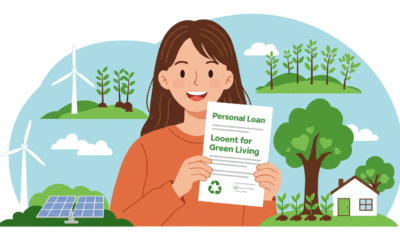

Environment
Determining Your Carbon Footprint (and How to Live More Sustainably)
Building a sustainable lifestyle is an ongoing journey. Like all journeys, it starts with just one step — or, in this case, a footprint. We’re referring, of course, to your carbon footprint, or the sum total of carbon emissions that each person’s lifestyle produces.
Did you know that the average American has a carbon footprint of 16 tons? This is the highest in the world and we have to do more to reduce it.
Knowing your carbon footprint is an important part of developing a more sustainable lifestyle. This guide will introduce you to the basics of what a carbon footprint is and how to start reducing yours. Plus, we’ll talk about some of our favorite lifestyle hacks, from line drying clothes to using eco-friendly trash bags. These simple steps allow anybody to start reducing their carbon footprint by a little bit every day!
What Is a Carbon Footprint?
The Nature Conservancy defines a carbon footprint as “the total amount of greenhouse gases (including carbon dioxide and methane) that are generated by our actions.” Let’s look a little more closely at what that means.
Much as walking creates footprints in the soil, activities that emit greenhouse gases create a “carbon footprint” in the Earth’s atmosphere. From driving to work to eating a burger to turning your heat on in the winter, a huge number of everyday activities produce greenhouse gases. A carbon footprint calculates the total impact of all of these.
The point of calculating your carbon footprint isn’t to shame yourself or bring on despair. Many people have no idea that their lifestyles produce so much carbon, and there’s only so much that the average person can do by themselves.
Knowing your footprint, however, gives you a lot of options when it comes to doing your part and helping the environment! You will understand the benefits of taking the steps to live eco-friendlier. We’ll talk about some of those choices in a little bit. But first, let’s learn about how carbon footprint calculations work.
Finding Your Carbon Footprint
So, how can a person find their personal carbon footprint? The best option is usually to use an online carbon footprint calculator.
A footprint calculator comes loaded with data for common activities like driving a car or eating meat. You’ll plug in numbers such as, for example, your home’s heating bills or the miles you put on your car every week. In addition, you’ll usually answer questions about topics such as where you live, how you heat your home and what kind of vehicle you drive. These questions will help improve the accuracy of the calculation.
Numerous free carbon footprint calculators are available online. Each one works a little differently and includes different factors, so it’s worth trying multiple calculators to compare their results. Generally, a calculator that includes more factors will give you a more accurate picture of your carbon footprint.
Some carbon footprint calculators will also highlight areas where your resource consumption is highest and suggest strategies for reducing it. While decarbonization ultimately has to happen on a societal level that includes businesses and governments, individual choices are most definitely part of the picture, too.
Living More Sustainably: 4 Ways You Can Start Reducing Your Footprint
Reducing your carbon footprint doesn’t mean swearing off technology and living in an off-grid cabin for the rest of your life. (If that’s what you want to do, we won’t discourage you, but don’t feel obligated!) Instead, you can get started with any of these four simple ways to create a lower-carbon lifestyle for yourself and your family.
1. Dry your laundry on a clothesline or use a heat pump dryer.
Running a dryer uses natural gas and thus produces carbon emissions. By some estimates, switching from dryers to clotheslines on a mass scale could save the Earth from millions of tons of greenhouse gas emissions per year.
You could also consider a heat pump clothes dryer. If you don’t mind a slightly longer drying time, these dryers significantly reduce the energy required to run the dryer and don’t require ventilation.
2. Reduce the amount of meat in your diet.
Meat production, and beef in particular, is a big contributor to methane emissions. Eating less meat is a highly effective way to reduce your footprint, and it doesn’t have to mean going vegetarian or vegan.
According to one study, simply cutting down on meat can lower your carbon footprint by up to one-third. That approach is on display in trends like Meatless Mondays, which encourages people to skip meat just one day a week.
3. Use reusable or recycled products when you can.
Another way to reduce your footprint is to avoid single-use plastic. Reusable products, such as a personal water bottle to replace disposable plastic water bottles, are a great place to start.
When you can’t avoid single-use plastic, try post-consumer recycled plastic products. Eco-friendly trash bags, for example, are made from recycled plastic. That reduces the amount of new plastic that gets created in their manufacturing process.
Finally, don’t forget to keep your own recyclables clean and well sorted. Recycling contaminants from the garbage are a big problem, so make sure only recyclable items make it into your curbside bin! Grab some blue recycling bags if you have trouble keeping your bins straight.
4. Walk, bike or take public transportation where it’s feasible.
Driving less could have a potentially huge positive effect on carbon emissions. While few Americans outside urban cores can give up their cars entirely, it can be surprisingly manageable to work other options into your lifestyle.
Try replacing short trips around town with biking if it’s safe to do so or find a bus or train that can take you where you’re going. Looking to embrace life at a slower pace? Try walking to your destination. It can be genuinely fun and keeps you connected to your community!
The sustainable lifestyle does involve some trade-offs, but you might find yourself surprised at how quickly you get used to them! Start by challenging yourself to make one change and let that be the single step that sets you on the path to a smaller footprint.


 Environment10 months ago
Environment10 months agoAre Polymer Banknotes: an Eco-Friendly Trend or a Groundswell?

 Environment11 months ago
Environment11 months agoEco-Friendly Home Improvements: Top 7 Upgrades for 2025

 Features9 months ago
Features9 months agoEco-Friendly Cryptocurrencies: Sustainable Investment Choices

 Features10 months ago
Features10 months agoEco-Friendly Crypto Traders Must Find the Right Exchange




























